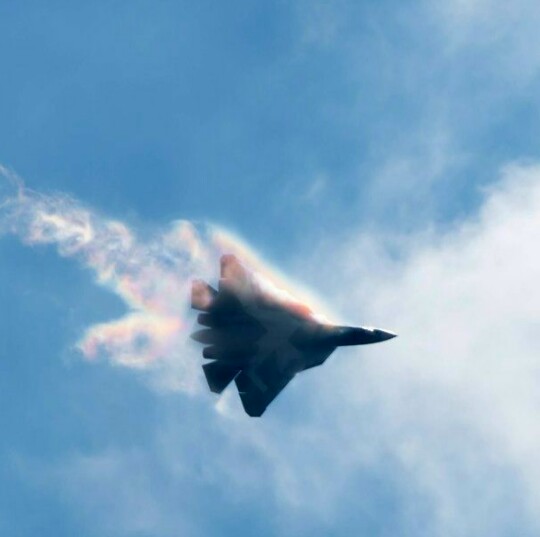"What radar reduction" basic rule of designing an stealth or low reflective surface is making sure designers have made least amount of surface which makes a right angle with the incoming waves,second basic point is neutralizing areas with conical or circular shape(no way they can be made canted)su57 doesn't took account of that basic thing before putting a circular IRST,another thing is when designers design an stealth aircraft,the work hard to keep minimal hotspots for the direct return of the microwaves,this is done by less moving parts,or hiding moving parts,conforming wing and body integration which Su57 some how does but again putting a levcon which moves during the flight in the front end is no less than a radar reflector ...I can point many areas were Su57 completely dodged many basic laws. It depends upon the kind of systems you use,IRST is use along with the main radar and a combine cue for the target is generated by the most advance capabilities,no such thing exists in any Russian aircraft. Let me show you this again
This is not even a partial serpentine intake,the choice of intake and engine placement is derived from the flanker family and infact the su57 is an effort to make Sukhoi27 stealthy with all the limited money and resources than any discrete new design......Radar blockers and all other bullshit only proves how messed up it was to begin with,Russia has no capability to hide engine like Lockheed did in the F22 and the f35 and mind you engines are not directly placed behind the intake in the F22 and the f35 but are in the Sukhoi 57..their is no comparison of Russian Sukhoi with f35 ,it simply doesn't stand a chance in any criteria....Moreover F35 probably doesn't have as modern IRST as Skyward G,but the thing is, it's a conformal sensor and it doesn't contribute in the RCS and still does the job....F35 radar is decades ahead of the Russian one,Russians first need to operationalize an AESA radar in their aircraft fleet before taking on Americans who are building and using airborne aesa radars from over 2 decades...
This is one of those why are such installments made on aircraft and why they would choose it. The IRST has material that has RCS reduction measures(yes they same as the fan blades) But there have QWIP IRST claim capabilities that have seen aircrafts at a way farther distance and with the infrared systems installed on the F-35 no one can decide how far or what kind of aircrafts they can detect with their infrared systems. Also with regards to the LEVCON there is more vortex and lift for the Su-57 as the trade-off with a better angle of attack and quicker stall recovery. But lets move on to why they still chose maneuverability for some features over stealth.
No one cares what your imagination brings you to, it is written in the patent that it comes with partial serpentine ducts. The reduction measures have been given in the patent but knowing the snake oil salesman of other 5th gen aircrafts you wont find an overall RCS reduction measure comparison they would do from 4th to 5th gen aircrafts. Your imagination is running wild again, radar blockers reflect the radio waves away from radar source along with RAM features for the engine, you cant determine any value reductions
I do not know if its a good idea that the F-35 does not have supersonic maneuverability, in fact I would feel sorry for an F-35 dog-fighting an Su-57. But there is one thing that cant be denied here and that is the F-35 is still undergoing block upgrades, even though F-35 production lines zerg rushed 100 aircrafts to come out. Such expenses of refitting new avionics become quite a paysome burden for the F-35. GaN modules for Himalayas, khibliny and tarantula were introduced in 2014. late 2014 the Su-57s were fitted with the himalayas, 2016 new khlibiny were tested in syria for su-35 and in 2018 tarantula was tested fitted for the Su-34. KRET already announced in their articles to have these modules on airborne aircrafts and EW systems. I do not recall the F-35 getting NJGs. KRET has also announced in 2019 photonic EW systems being made with news statements of ROFARs being integrated in the mid-2020s and of course not too long ago there has been announcements of new engines with new avionics. The F-35 did go from 1200 to 1600 modules but that was all done on the early phases and with the amount of aircrafts already produced I have my doubts they would start an avionics upgrade because they would have to re-test 100s of aircrafts with new systems on already operational aircrafts causing expenses to sky rocket.
Go find any article on the web but PICs have better receiver sensitivity than MMICs. Which would allow their aircrafts to quickly find and suppress aircrafts faster than aircrafts fitted with 1600 T/R modules. The Su-57 in early 2009 was given 2,236 modules and that is not counting the radar changes that were done to the Su-57 going from 240 to 360 degrees in a 2019 announcement, ROFAR is an even more monstrous upgrade than what they announced in 2019. With Stealth and far superior EW suppression the F-35 would basically be dog fighting this aircraft.


